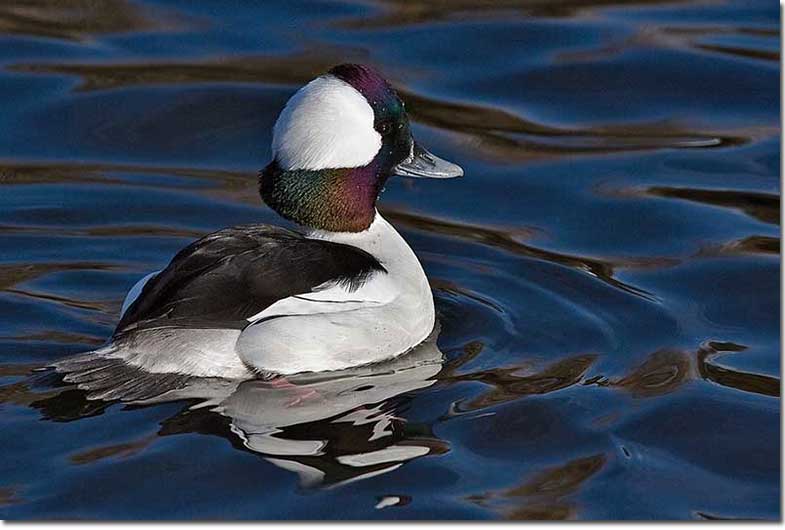
Ducks are such fancy birds! These beautiful waterbirds are also easy to see and fun to watch!
In North America, we’re lucky to have a lot of ducks to look at. Although we see lots of waterfowl in coastal waters, inland states like Colorado can also be excellent places to watch ducks!
Have you seen a lot of ducks in Colorado? We bet you have seen good numbers of ducks on the state’s lakes and marshes but how many did you identify?
This list of the most common ducks in Colorado will help!
Can You See Ducks in Colorado?
Based on eBird data, we made a list showing the most common ducks in Colorado.
We arranged these duck species from most common to least common. We also included key information about their behavior and habitats. To help identify these waterbirds, we mention key field marks!
Mallard
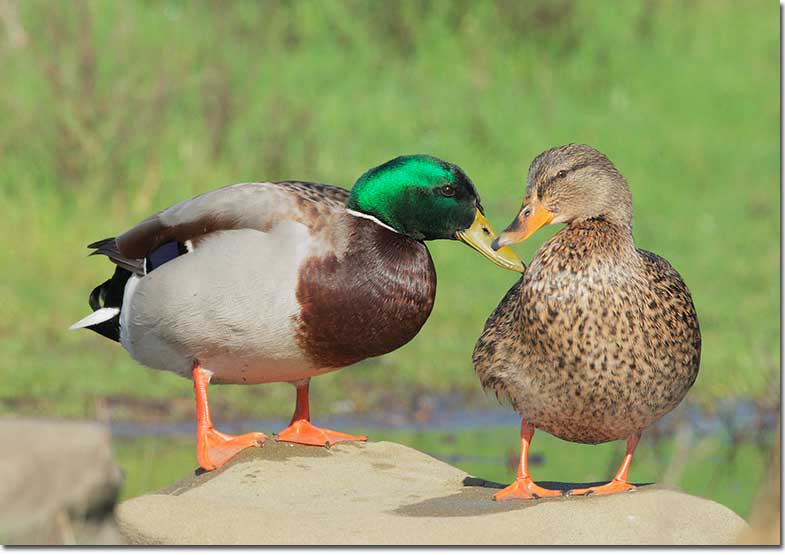
Scientific name: Anas platyrhynchos
Length: 23 inches
Wingspan: 35 inches
Mallards are the most familiar duck species. For lots of folks, this is “the duck”. They have been domesticated for centuries and lots of them are fed at urban ponds and lakes.
The males have a dark green head, narrow white collar, yellowish beak, and dark brown chest. Female Mallards, though, can be trickier to identify. They are brown with some paler brown and dark markings, and have a gray-brown neck and head with a dark cap, and a dark line through their eyes.
Mallards are easy to spot year-round and their populations remain stable.
Key identifications:
- Big duck with a glossy green head and yellowish beak.
- The female has a dark center mark on her orange beak.
- Short, pale, or white tail.
Gadwall
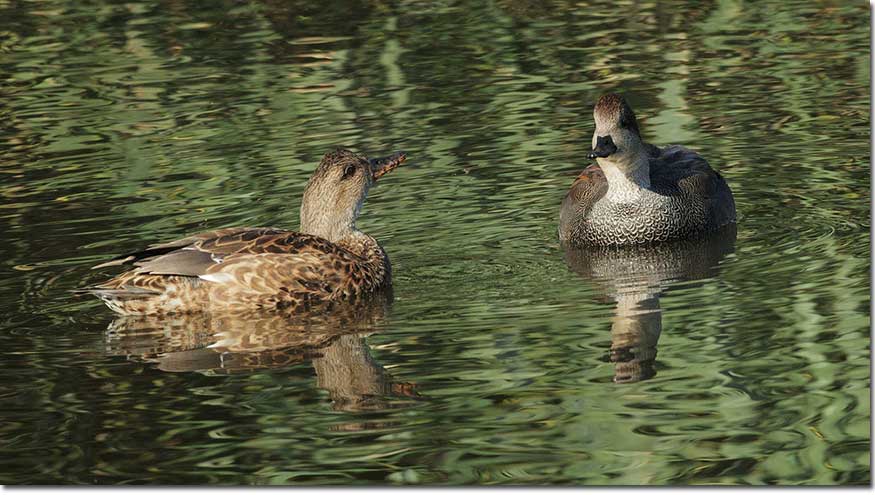
Scientific name: Mareca strepera
Length: 20 inches
Wingspan: 33 inches
Gadwalls are medium-sized ducks with a small white patch on the base of each wing. Males are gray ducks with a paler grayish head, some brown feathers on their wings, and a black rump, tail, and undertail.
Female Gadwalls look a lot like female Mallards. Like female Mallards, they also have an orange and black beak but it is mostly gray on the upper part of the bill.
In flight, both sexes show white bellies, the small white mark on their wing, and much white on their underwings.
Gadwalls forage for seeds and other plant matter in and near shallow water.
Key identifications:
- Male is mostly gray with black rear end.
- Female has grayish head and gray and orange beak.
- Small white patch on base of wing.
Northern Shoveler
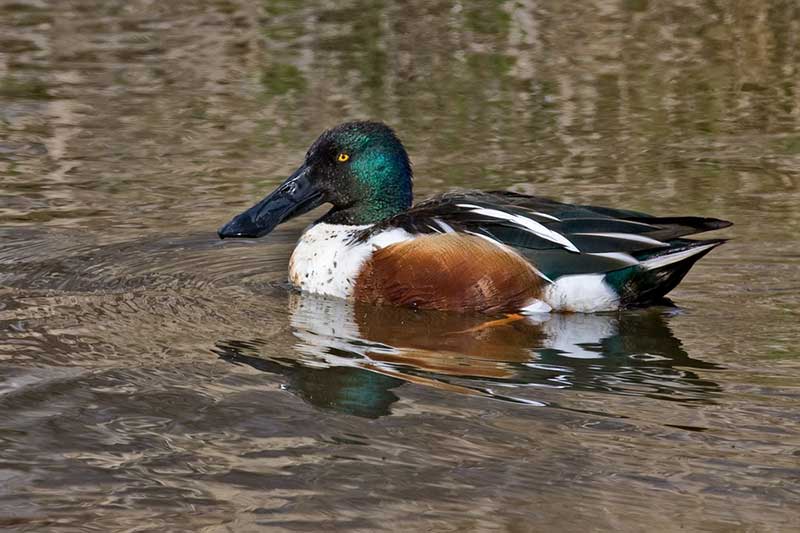
Scientific name: Spatula clypeata
Length: 19 inches
Wingspan: 30 inches
Northern Shovelers are a distinctive duck species with a big, prominent beak. Males have striking plumage with a dark green head, and white and chestnut underparts. They are also white and gray on their back, have orange legs, and show blue shoulders in flight.
Female Northern Shovelers are tawny-brown ducks with lots of buff markings, and an orange and gray beak. Both sexes also have a pale tail.
These pretty ducks like to float in marshes and other shallow wetland habitats. They often form flocks and we can see them foraging with Blue-winged Teals and other dabbling ducks. Like many other duck species, Northern Shovelers feed on a combination of plant matter and small aquatic creatures.
This species breeds in shallow wetlands, but their population is bigger during the non-breeding season.
Key identifications:
- Over-sized, flat beak.
- Male has a white breast, red-brown sides and belly, and dark green head.
- Female has a pale tail and orange and gray beak.
Common Goldeneye
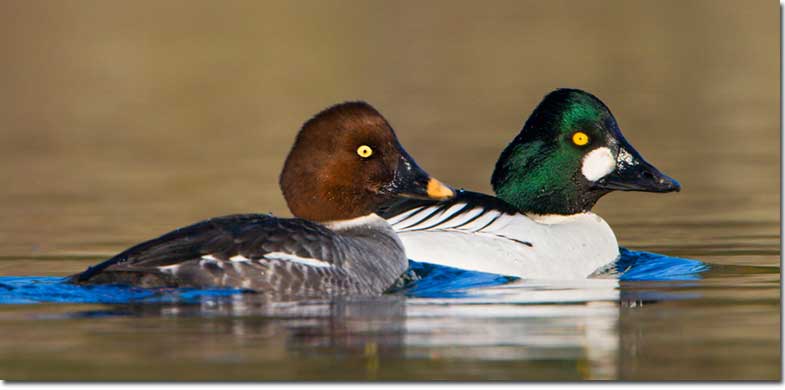
Scientific name: Bucephala clangula
Length: 18.5 inches
Wingspan: 26 inches
Common Goldeneyes are small ducks with a stout, triangular beak. Males are mostly white with some black markings and have green iridescence on their black heads. They also have a round white patch on their face.
Female Common Goldeneyes have gray bodies with a white belly, a pale collar, and a dark, gray-brown head. They also usually have a pale tip on their beaks.
Both sexes of this pretty little duck have pale eyes and, in flight, show big white patches on the base of their wings.
Common Goldeneyes usually winter in Colorado, you can spot them by their behavior – diving under water to forage for small mollusks and other aquatic creatures.
Key identifications:
- Small duck with a fairly large, stout blackish beak, and pale eyes.
- Male is black and white with a round white mark on his green-black face.
- Female has mostly gray body with a dark brown head.
American Wigeon
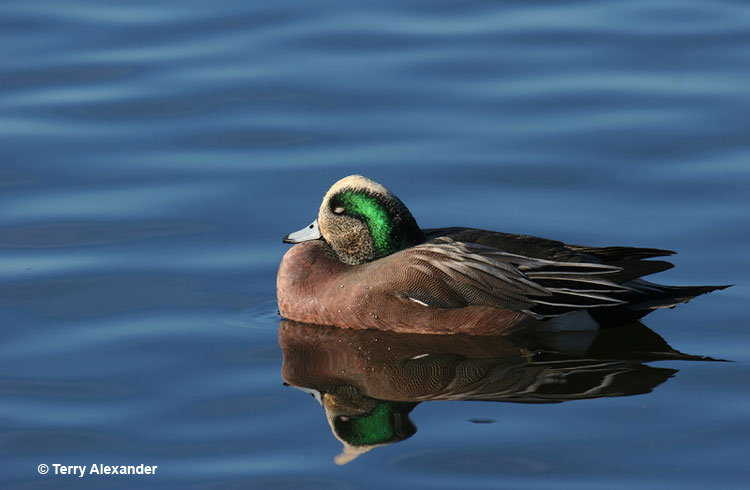
Scientific name: Mareca americana
Length: 20 inches
Wingspan: 32 inches
American Wigeons are medium-sized ducks with a smallish gray beak. Males are gray with a white crown, some dark green near their eyes.
Females look like males but lack white and green on their heads and are a bit duller in general. Both sexes have pointed tails and a white belly especially visible in flight.
American Wigeons like to graze grass and eat grain while walking at the edge of wetlands and in wet fields. They can also pick plant matter and small creatures from the surface of the water and even steal food from other ducks!
Key identifications:
- Rather small pale gray beak.
- Peach or gray-orange chest and flanks.
- Male has a white crown and white shoulders, female has grayish head with a dark area around her eyes.
Green-winged Teal
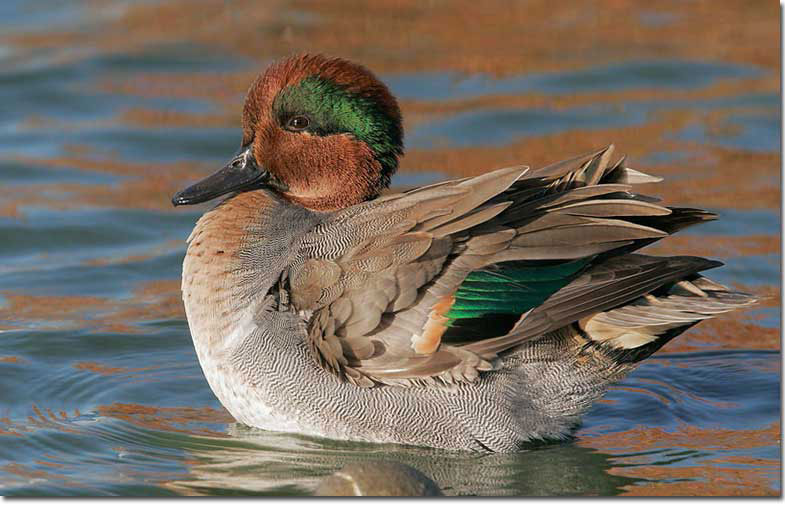
Scientific name: Anas crecca
Length: 14 inches
Wingspan: 23 inches
Green-winged Teals are small waterfowl with a smallish, dark beak, and a dark green patch at the base of each wing. Males of these cute little ducks are mostly gray and have a chestnut head with a dark green patch, speckled, buff chest, and narrow white bar near their chest.
Females are mostly mottled brown with a dark line through each eye. Both sexes have a buff mark on the edge of their tail, and show a white belly in flight. Green-winged Teal like to forage for plants and small creatures in the shallow water of marshes and other wetland habitats.
Although this small duck species can form flocks, we often see them in pairs or only in small groups. They also migrate north later than other duck species, so keep your eyes peeled for them in April.
Key identifications:
- Very small duck.
- Buffy mark along the edge of each side of its tail.
- Small dark beak and dark green patch edged with buff on its wings.
Common Merganser
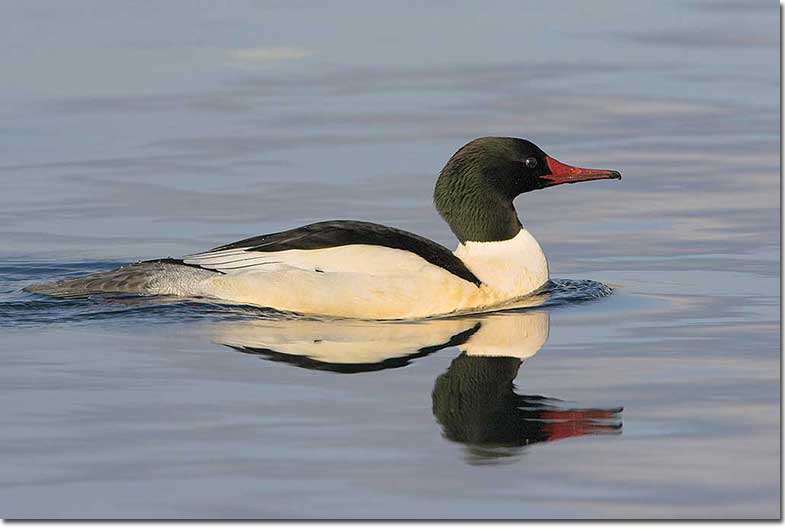
Scientific name: Mergus merganser
Length: 25 inches
Wingspan: 34 inches
Common Mergansers are big and slender ducks with pointed red beaks. Breeding males are white with a dark green head and some black on their back and wings.
Female and nonbreeding male Common Mergansers are gray with a brown head, small white throat, and white on their belly.
When flying, this species shows a lot of white on the base of their wings. They have fast, direct flight and, after the breeding season, usually occur in small flocks.
These highly aquatic ducks catch fish and crustaceans after pursuing them underwater. They nest on cold lakes and rivers, and stay in Colorado throughout the year.
Key identifications:
- Red, pointed beak.
- Distinct brown head with a white throat.
- Males have all white underparts.
Hooded Merganser
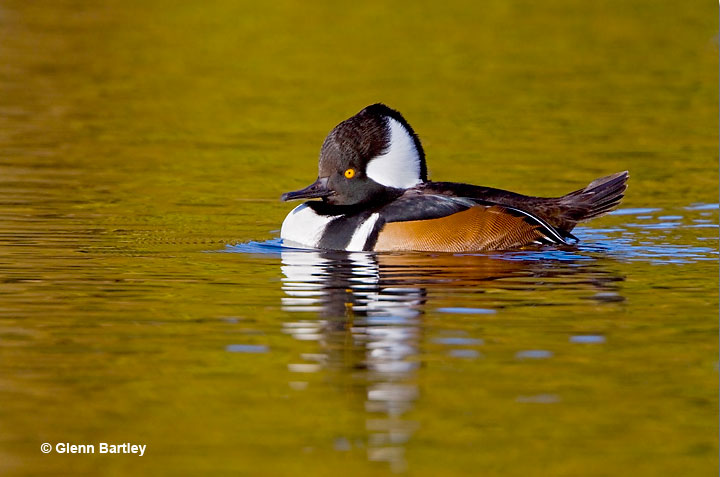
Scientific name: Lophodytes cucullatus
Length: 18 inches
Wingspan: 24 inches
The Hooded Merganser is one of the prettiest ducks in North America. Breeding males have a distinctive head and some white on the sides.
Females aren’t as colorful but are still pretty in their own way. These brown-gray birds have a slender, yellowish beak, and a deep, caramel-colored, rounded crest.
Hooded Mergansers dive for crayfish, small fish, and other small creatures in wooded swamps and marshes. We don’t see them flock together as much as other ducks do, and they usually occur as pairs.
Key identifications:
- Small duck with a small, slender beak.
- Blocky or rounded head.
- White belly and a bit of white on the base of narrow wings.
Bufflehead
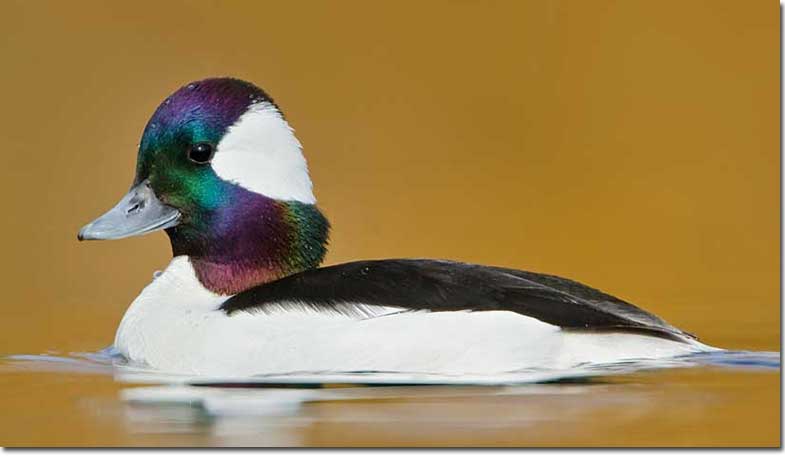
Scientific name: Bucephala albeola
Length: 13.5 inches
Wingspan: 21 inches
Buffleheads are small, cute ducks with rounded heads and stout little beaks. Males are bold, black and white birds with a big white patch on their head. In good light, their head also has green and purple iridescence.
Female Buffleheads are more gray-brown with a white belly, and have a smaller white head patch.
These ducks breed on northern, forested lakes in Alaska, Canada, and parts of the northwestern USA. They do breed in Colorado, but you are more likely to see them during winter.
Buffleheads dive to forage for mollusks and other small creatures. They also occur in flocks, sometimes with goldeneyes and other diving birds, especially in winter.
Key identifications:
- Small chunky duck with stout gray beak.
- Rounded head with a bold white patch.
- Mostly black and white or grayish with a white belly and small white wing patch.
Lesser Scaup
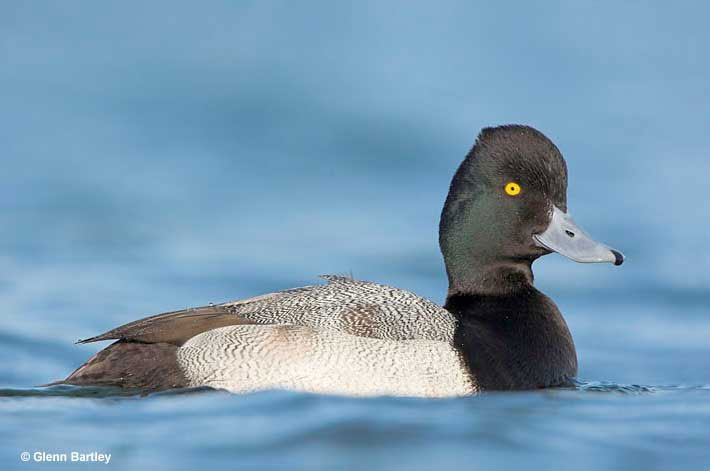
Scientific name: Aythya affinis
Length: 16.5 inches
Wingspan: 25 inches
Lesser Scaups are smallish or medium-sized diving ducks with a blue-gray beak. Males have a black head with dark green highlights and black chest, but females are dark brown.
Lesser Scaups dive to forage in lakes, reservoirs, and coastal bays for mollusks, crustaceans, and other aquatic creatures. In migration and winter, they often occur in flocks that can number in the hundreds!
These smart-looking ducks breed on remote lakes and marshes. They can be found year-round but in larger numbers during migration, as others move further north.
Key identifications:
- Bluish beak.
- Slightly peaked on the back part of its head.
- Male has black chest, gray body, and dark head, female has a white mark on the front of her face.
Redhead
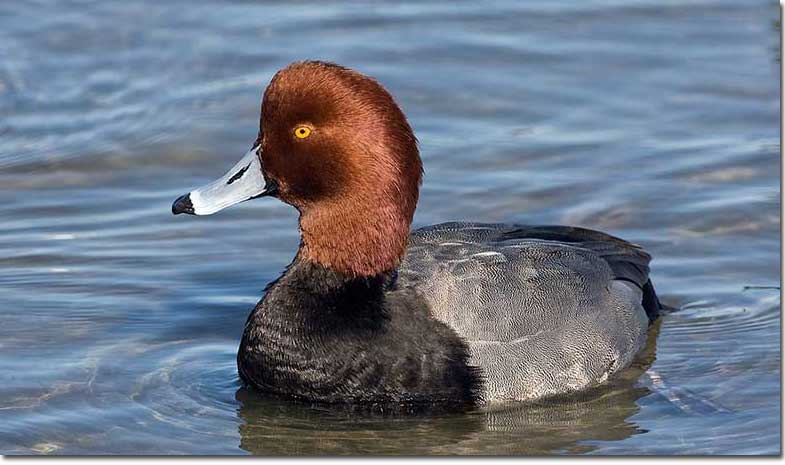
Scientific name: Aythya americana
Length: 19 inches
Wingspan: 29 inches
Redheads are medium-sized ducks that dive in lakes, reservoirs, and bays to catch mollusks and other aquatic animals. As their name hints, males are eye-catching with their rusty red heads, however females are much more laid-back. In flight, both sexes show gray upperwings and much white on their underwings.
Redheads breed in shallow marshes and lakes, but after breeding, they can occur in large flocks.
Key identifications:
- Blue-gray beak with a black tip.
- Male has dark gray body, black chest, and bright red-brown head.
- Female mostly tawny-brown with a buff throat.
Blue-winged Teal
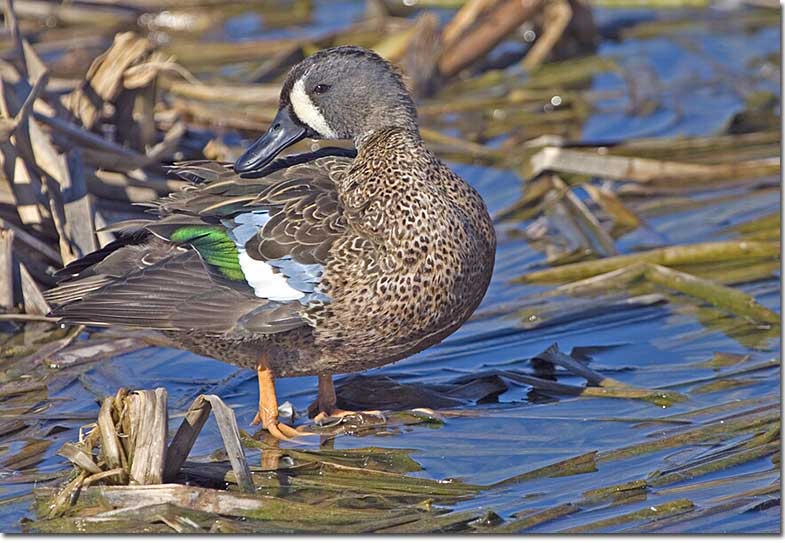
Scientific name: Spatula discors
Length: 15.5 inches
Wingspan: 23 inches
Blue-winged Teals are small ducks with brownish plumage and fairly big, dark beaks. In flight, just like their name says, both sexes reveal big blue patches on their wings. Blue-winged Teals usually occur in flocks, and in some places, they can number in the thousands!
They like to dabble for plants and small creatures in rice fields, marshes, and other shallow water wetlands. They are migratory birds, and only stay in Colorado for the breeding season.
Key identifications:
- Small duck with a dark beak and white crescent mark on its face.
- Female has a dark line through her dark eyes.
- Blue or blue-gray shoulders on its wings.
Ruddy Duck
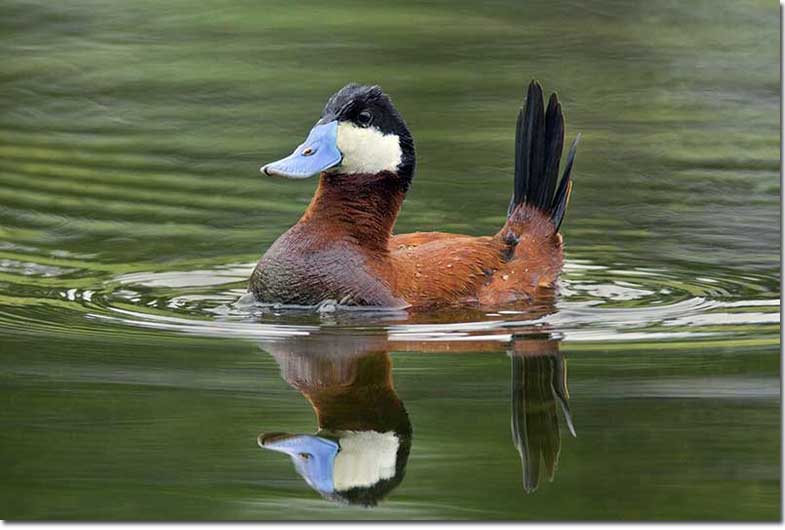
Scientific name: Oxyura jamaicensis
Length: 15 inches
Wingspan: 18.5 inches
Ruddy Ducks are small diving ducks with a unique, stocky look and a stiff tail. Breeding males are beautiful rusty brown birds with white throats and cheeks. They also have a big blue beak that contrasts with the other colors on their head.
Female Ruddy Ducks are grayish birds with darker, more uniform upperparts. They have a duller, darker, more grayish beak than the male.
Ruddy Ducks dive underwater to forage for small aquatic creatures.
This small duck species breeds in shallow marshes and lakes and stays in Colorado year-round.
Key identifications:
- Small duck with big bluish beak and a dark cap.
- White cheeks or a dark line on pale cheeks.
- Longish, stiff tail often held upright.
Wood Duck
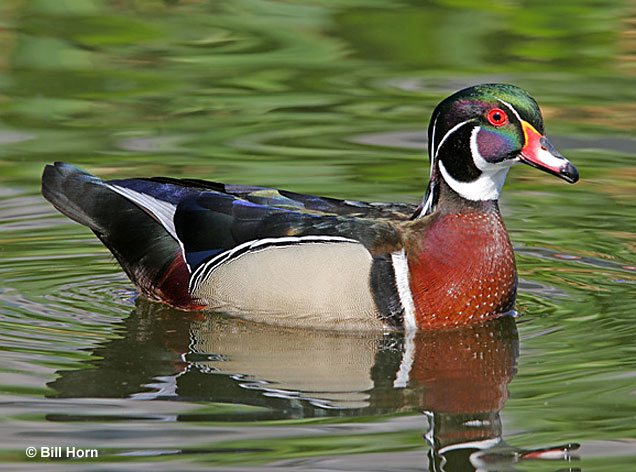
Scientific name: Aix sponsa
Length: 18.5 inches
Wingspan: 30 inches
Wood Ducks are seriously ornamental birds. The males look exotic, almost too exotic for North America, while the females look much more laid-back.
Wood Ducks usually occur in pairs but can also form small flocks that forage for acorns, plant matter, and small creatures in and near water. We often hear these ducks give their odd, squealing whistle vocalization before we see them.
Key identifications:
- Slender duck with a longish tail and a blocky head.
- Ornate plumage a short, reddish beak.
- Dark wings with a narrow white line on the base of the trailing edge.
Cinnamon Teal
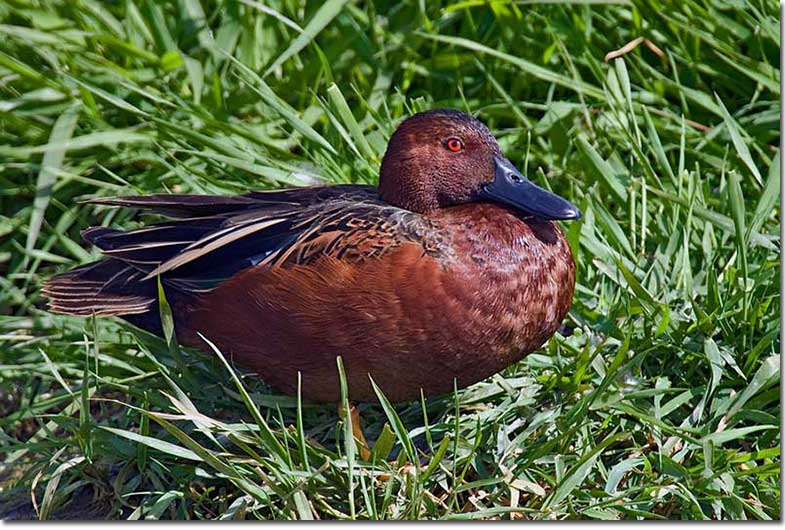
Scientific name: Spatula cyanoptera
Length: 16 inches
Wingspan: 22 inches
Cinnamon Teals are small ducks with reddish eyes and a fairly large, dark beak. Breeding males are handsome with their reddish-chestnut plumage. Females are duller brown with some buff markings.
Cinnamon Teals dabble for plant matter and small creatures in shallow marshes and at the edges of shallow lakes. Colorado is one of their breeding areas, they are usually only found during warmer periods.
Key identifications:
- Rich, red-brown plumage.
- Female has a reddish eye and a plain face.
- Blue or blue-gray shoulders on its wings.
Frequently Asked Questions
How many duck species does Colorado have?
Colorado has 34 duck species. However, at least 8 of those are rare vagrants.
Do ducks leave Colorado for the winter?
Yes, many ducks leave Colorado for the winter.
Where are ducks usually found in Colorado?
In Colorado, ducks are usually found in marshes and on lakes and reservoirs throughout the state.

